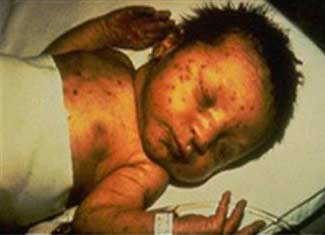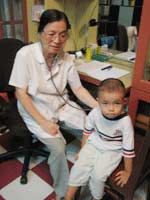Pregnant Women Infected with Rubella in the First Trimester Face High Risk of Birth Defects
According to Dr. Nguyen Ngoc Vinh, head of Internal Medicine A department at the Tropical Diseases Hospital, if a pregnant woman is infected with Rubella in the first trimester, there is a 50% chance that her child will be born with congenital defects. He emphasizes the importance of consulting a doctor if a pregnant woman contracts Rubella during the first three months of pregnancy.
Dr. Vinh noted that global statistics show that for pregnant women infected with Rubella in the first trimester, 50% of the children born are likely to have congenital abnormalities. The risk decreases to over 30% in the following three months.
 |
| Newborns with Congenital Rubella Syndrome often exhibit symptoms such as deafness, blindness, developmental delays, cataracts, retinopathy, congenital pneumonia, hepatosplenomegaly, congenital heart defects, and bone damage… (Photo: VNN) |
Dr. Vinh explained that the first three months of pregnancy are crucial for fetal development. This stage involves the formation of vital organs, from the eyes and mouth to limbs. The Rubella virus can interfere with these developmental processes.
Chronic Rubella infection in the mother can result in infection of the fetus during acute episodes. The Rubella virus can inhibit cell division or cause cellular damage (leading to organ damage, eye defects in newborns…), or it may harm fetal blood vessels, the inner ear, heart, and brain.
Mother’s Illness, Child Suffers the Consequences
On February 12, 2001, a baby girl named N.T.L.D was born weighing 1,700 grams and was diagnosed postnatally with the following conditions: congenital abnormalities, including microcephaly, microphthalmia, and cataracts. Additionally, after conducting several tests, she was found to have an atrial septal defect, a patent ductus arteriosus, and brain damage suspected to be due to fetal infection. Six months later, it was discovered that she was deaf in both ears.
Four months after birth, she underwent surgery to close the patent ductus arteriosus. Two months later, she was back on the operating table due to retinal disease.
By July 13, 2004, N.T.L.D was severely malnourished, unable to walk independently, weighing 9.8 kg, measuring 90 cm in height, and with a head circumference of 46 cm. Her eyesight was severely impaired, requiring glasses, and her hearing loss was rated at level 4 (currently wearing hearing aids). She could not speak and had very limited comprehension.
The mother of N.T.L.D, Ms. T.T.P.A, 23 years old, was healthy but had not been vaccinated against Rubella. However, after five weeks of pregnancy, she experienced mild fever (38-38.5 degrees Celsius), a rash on her face, and on her limbs which spread throughout her body.
After a prenatal check-up on July 5, 2000, the doctor examined the amniotic fluid and found the gestational sac to be six weeks old in the uterus. A follow-up examination on February 2, 2001, revealed that at 37.5 weeks, the fetus was underdeveloped, had oligohydramnios, brain ventricular malformation, and pericardial effusion.
“Consider Abortion” if the Mother is Infected with Rubella
Baby N.T.L.D is one of four typical cases of Congenital Rubella Syndrome in infants originating from prenatal infection.
 |
| Associate Professor Dr. Le Diem Huong: Pregnant women often contract the disease very early (in the first three months of pregnancy), thus increasing the risk of Congenital Rubella Syndrome in the child (Photo: H.Cat) |
These illustrative cases were reported by Associate Professor Dr. Le Diem Huong, a specialist in Pediatrics and Neonatology, at the “Vietnam – France Obstetrics and Gynecology Conference V” held in Ho Chi Minh City on May 10-11, 2005. She is currently working at the Ho Chi Minh City International Women’s Hospital.
In her report, Associate Professor Dr. Le Diem Huong and her colleagues noted that most of these mothers had not been vaccinated before giving birth, and the symptoms of fever and rash occurred before the 12th week of pregnancy. All the children were firstborns.
The mothers were quite young, aged 23-25, with no history of miscarriage or stillbirth. Before becoming pregnant, these mothers did not exhibit clinical symptoms of Rubella, but they often contracted the disease very early in the first trimester, resulting in a high risk of the baby being affected by Congenital Rubella Syndrome (CRS). Tests conducted on the mothers and babies showed a very high rate of Rubella virus infection.
The clinical manifestations in the pregnant women were clear: fever, rash, aches, and swollen lymph nodes in the first or second month, but none had undergone IgM testing to confirm the specific time of infection. At the obstetrics conference, Associate Professor Dr. Le Diem Huong confirmed that in these cases, the likelihood of primary infection occurring in the infant, who had no immunity to Rubella, is very high.
At that time, all the pregnant women were regularly monitored, and the clinical features of the infections were noted by the doctors, but there was little prior consultation regarding the potential health issues of the baby after birth.
For newborns, the virus in the mother’s blood can cross the placenta to the fetus when the mother is infected approximately one week before the rash appears and can last for 3-4 days after the rash has developed.
To detect maternal infection, the virus can be isolated from throat secretions, urine, or conjunctival fluid. The virus can be found in 80-90% of newborns infected with Rubella. In cases of infant mortality, the virus can be found in the heart, brain, kidneys, lungs, liver, spleen, and thyroid gland.
Rubella (German Measles) is a significant risk factor for fetal infection. Infection with the Rubella virus during pregnancy, especially in the first or last trimester, can lead to miscarriage, premature birth, stillbirth, and malformations…
Although the fetus may come into contact with Rubella antigens, newborns typically have a poor immune response. Therefore, the most severe consequence for the child after birth is Congenital Rubella Syndrome (CRS).
Children may experience deafness, blindness, developmental delays, cataracts, retinopathy, congenital pneumonia, hepatosplenomegaly, congenital heart defects, and bone damage… with a rate of 0.1% to 2%.
On the other hand, according to Associate Professor Dr. Huong, the treatment costs for affected cases are very high and often ineffective. Therefore, currently, pregnant women infected with Rubella in the first trimester are advised to consider abortion.
Screening and Vaccination
 |
| Pregnant women need to consult a doctor when infected with Rubella in the first trimester to discuss whether to continue the pregnancy. (Illustrative Image) |
By screening and vaccinating those at risk, particularly women of childbearing age, countries have shown effectiveness in preventing Rubella infections and CRS.
The vaccine against measles, mumps, and Rubella is effective in providing immunity against Rubella and reducing the incidence of CRS.
The vaccination center at Pasteur Institute in Ho Chi Minh City, along with the entire preventive healthcare team in districts and towns, offers various types of vaccines, including PRIORIX, TRIMOVAX, and MMR II, with prices ranging from 110,000 to 120,000 VND per dose.
For children, they must receive 2 doses of MMR II; the first dose at 12-15 months and the second dose at 4-6 years of age.
Women of childbearing age must receive at least one dose. Pregnant women cannot receive this vaccine. These pregnant women will be vaccinated after giving birth to protect them for future pregnancies.
Scientifically, Dr. Nguyen Ngoc Vinh believes that during the current outbreak in Ho Chi Minh City, vaccination is already delayed.
Rubella typically occurs in winter or spring and spreads rapidly through respiratory droplets. The disease spreads through coughing and sneezing when in contact with infected individuals.
“In fact, patients can transmit the virus up to 10 days before the rash appears and even 2 weeks after the rash has developed, so by the time people realize they need to get vaccinated, it is often too late for effective prevention.” Dr. Vinh explained.
Therefore, when planning to conceive, mothers should get vaccinated against Rubella at least three months prior to pregnancy.



















































